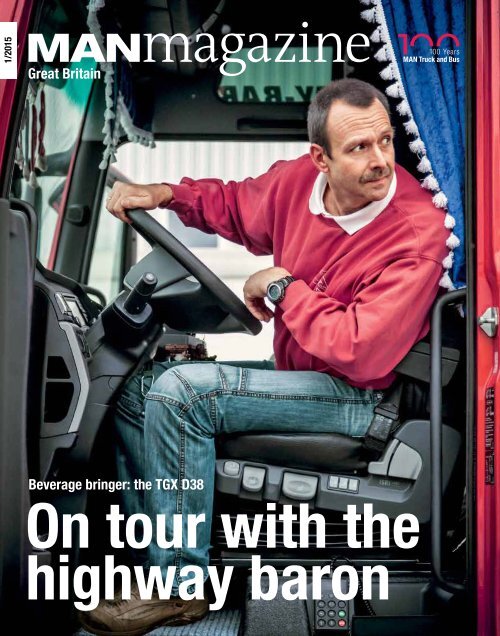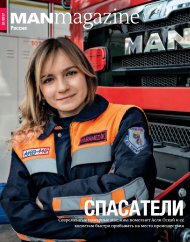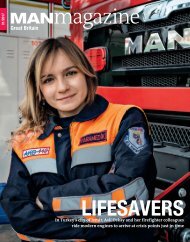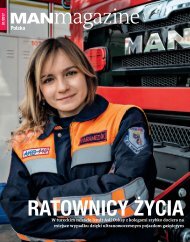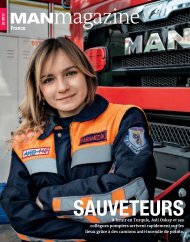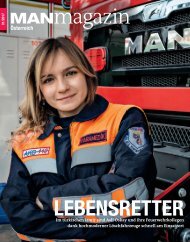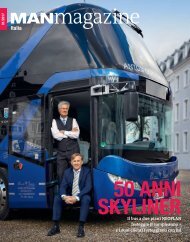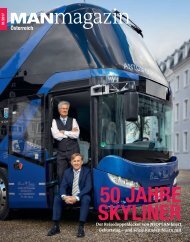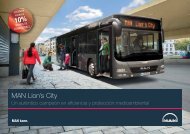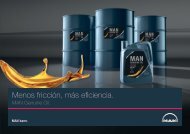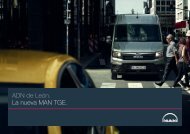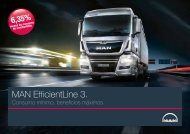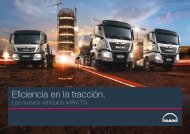You also want an ePaper? Increase the reach of your titles
YUMPU automatically turns print PDFs into web optimized ePapers that Google loves.
1/<strong>2015</strong><br />
Great Britain<br />
Beverage bringer: the TGX D38<br />
On tour with the<br />
highway baron
man magazine<br />
1/<strong>2015</strong><br />
Explore much<br />
more of<br />
on your tablet.<br />
digitally<br />
Great Britain<br />
for Android<br />
Simply<br />
download the<br />
app for free:<br />
for ios<br />
1/<strong>2015</strong><br />
Great Britain<br />
The best of MAN’s world<br />
Beverage bringer: the TGX D38<br />
On tour with the<br />
highway baron<br />
masthead<br />
MAN magazine is published twice a year<br />
in 16 languages.<br />
published by MAN Corporate Communications<br />
Andreas Lampersbach (V.i.S.d.P.),<br />
Ungererstraße 69, 80805 Munich, Germany<br />
Responsible editor & project manageR<br />
Joachim Kelz, Tel.: +49. 89. 1580-1175,<br />
magazin@man.eu, www.man.eu<br />
EDITORIAL, GREAT BRITAIN Verity Cullum<br />
Publisher C3 Creative Code and Content GmbH,<br />
Heiligegeistkirchplatz 1, 10178 Berlin, Germany<br />
Tel.: +49. 30. 44032-0, www.c3.co,<br />
Shareholders of C3 Creative Code and Content GmbH<br />
are the Burda Gesellschaft mit beschränkter Haftung<br />
(limited liability company), Offenburg, and the KB Holding<br />
GmbH, Berlin, with 50% each. Sole shareholder of<br />
the Burda Gesellschaft mit beschränkter Haftung is the<br />
Hubert Burda Media Holding Kommanditgesellschaft<br />
(limited partnership), Offenburg. Shareholders of<br />
KB Holding GmbH are Mr. Lukas Kircher (managing<br />
director, Berlin) and Mr. Rainer Burkhardt (managing<br />
director, Berlin) with 50% each.<br />
Editors & Authors Klaus-Peter Hilger (resp.),<br />
Yasmine Sailer (dep.). Freelance authors: Tobias Birzer,<br />
Alexandra Grossmann, Dr. Wolfgang Hörner, Martin<br />
Kaluza, Marcus Schick, André Schmidt-Carré<br />
international Editors Patricia Preston<br />
(resp., freelance editor), Asa. C. Tomash<br />
MANAgiNg editor Sara Austen<br />
Concept Stefan Lemle, A New Kind<br />
(freelance contributor)<br />
Graphics Micheline Pollach, Andrea Hüls, Christian<br />
Kühn, Anna-Sophie Werner (freelance contributor)<br />
graphics editor Elke Latinovic,<br />
André Kirsch (freelance contributor)<br />
cover image Christian Grund<br />
productioN C3 Creative Code and Content GmbH<br />
printing Gotteswinter und Aumaier GmbH,<br />
Joseph-Dollinger-Bogen 22, 80807 Munich, Germany<br />
reproduction permitted with reference.<br />
Any changes must be coordinated with the editors.<br />
advertising service Zeitzeichen Vertriebs GmbH,<br />
Radka Neumann, Tel.: +49. 8323. 99 84 630,<br />
radkaneumann@zeitzeichen.de<br />
Copyright ©<strong>2015</strong> MAN and C3 Creative Code and<br />
Content GmbH<br />
04<br />
12<br />
COVER STORY<br />
The MAN TGX D38 proves<br />
its prowess during beverage<br />
transport runs.<br />
06<br />
18 28<br />
content<br />
04 The sandman<br />
Peter Meyer shuttles tourists around<br />
Fraser Island in a converted MAN truck.<br />
06 Ready for the future<br />
The key milestones of MAN’s century-old<br />
tradition in commercial vehicle production<br />
12 Fluid run<br />
One of the first delivered MAN TGX D38<br />
models transports beverages and more.<br />
18 Under ground<br />
Reporting for mine duty, an MAN truck<br />
travels underground in pieces.<br />
24 Update for a better line<br />
During a test run, the MAN TGX<br />
EfficientLine 2 proves its efficiency.<br />
28 On location<br />
News from the british MAN-Market<br />
32 Systematic safety<br />
A wide range of MAN assistance systems<br />
improves the safety of truck traffic.<br />
What are the highlights of MAN’s century-old<br />
experience in commercial vehicle<br />
design and manufacturing? How is the new<br />
TGX D38 received by customers? And how is a<br />
four-axle truck hauled into a deep mine? This<br />
third issue of <strong>MANmagazine</strong> offers answers to<br />
these and other interesting questions. It reflects<br />
the world of MAN: a world shaped by<br />
technology, with fascinating topics drawn<br />
from the realm of trucks and buses.<br />
We hope you enjoy this edition of <strong>MANmagazine</strong>.<br />
You can also download the digital<br />
tablet version for free, which is available on<br />
iOS and Android.<br />
Photo: APPLE INC. Pr<br />
02<br />
03
man magazine<br />
1/<strong>2015</strong><br />
my man<br />
The sandman<br />
Find more images<br />
of Peter Meyer in<br />
action on Fraser<br />
Island in the app.<br />
Peter Meyer, 44, works as a ranger on Fraser<br />
Island. The Australian with German roots uses<br />
an all-wheel truck with a bus body to show visitors<br />
the island, which is made up entirely of<br />
sand, located off Australia’s eastern coast. His<br />
MAN vehicle never navigates a surfaced road.<br />
Is your MAN a serial vehicle? It’s an MAN<br />
driver’s cab saddled by a bus body. The vehicle<br />
has 28 seats and an MAN engine with 280 hp.<br />
We had it converted to an all-wheel drive.<br />
You drive on sand all day. How does that<br />
impact the machine? While operating on soft<br />
sand, you must maintain an extremely high<br />
engine speed, always approaching the red<br />
zone. Sand seeps in through all the cracks,<br />
while salt water, salt-laden air and mud will<br />
destroy any machine in the long run. I have<br />
been here for 20 years and have driven many<br />
different vehicles. Those coming from MAN<br />
are definitely the most enduring!<br />
As a driver, what do you need to watch<br />
out for? If you stop in the wrong place, the<br />
truck is simply going to sink. Just unladen,<br />
these vehicles weigh 13 tonnes – which makes<br />
tyre pressure all the more important! I drive<br />
with a pressure of 2.75 bar, while 7.6 or 7.9 bar<br />
would be standard on asphalt roads. This is<br />
done to enlarge the tyre footprint and thus<br />
float over the sand, rather than digging yourself<br />
into a hole. Quite a few inexperienced<br />
private sightseers come here with their expensive<br />
all-wheel vehicles, believing that they<br />
can drive anywhere. Ultimately, they get<br />
stuck – and I will pull them out again.<br />
Beach buggy: The 280-hp<br />
MAN vehicle never comes<br />
in contact with a tarred road.<br />
Photos: Martin Kaluza<br />
Australian ranger: For two decades,<br />
Peter Meyer has been driving tourists<br />
across the island on behalf of Fraser<br />
Explorer Tours.<br />
Road of sand: The beach serves as<br />
Fraser Island’s motorway – with the<br />
maximum permissible speed being<br />
80 kilometres per hour.<br />
04<br />
05
man magazine<br />
1/<strong>2015</strong><br />
Ready for<br />
the future<br />
1915<br />
Looking back on a history<br />
of more than 250 years,<br />
the MAN Group celebrates<br />
yet another significant<br />
anniversary in <strong>2015</strong>: The<br />
history of commercial<br />
vehicle construction at<br />
MAN began a century ago.<br />
An overview of the most<br />
important milestones.<br />
E<br />
ntered into the trade register of<br />
the City of Nuremberg on 21 June<br />
1915 was a new company, namely<br />
“Lastwagenwerke M.A.N.-Saurer”. The company<br />
had been established as a joint venture<br />
between Maschinenfabrik Augsburg-Nürnberg<br />
AG and Saurer, a Swiss producer of commercial<br />
vehicles. Soon thereafter, the first MAN-<br />
Saurer three-tonne truck left the joint factory<br />
in Lindau, Germany, on Lake Constance, followed<br />
by the first buses used as long-distance<br />
coaches by the Imperial Post Office, and transporting<br />
passengers as well as letters and<br />
parcels. This was the beginning of commercial<br />
vehicle construction at MAN, a success story<br />
that has not only decisively shaped the history<br />
of the company itself. With its advanced and<br />
often revolutionary innovations, MAN has significantly<br />
influenced the development of<br />
trucks and buses for the last 100 years – an endeavour<br />
that continues to this very day.<br />
Production shifted to the MAN plant in<br />
Nuremberg in 1916 and the company traded<br />
as “M.A.N. Lastwagenwerke” following the departure<br />
of Sauer two years later. In 1924, MAN<br />
presented the first truck with a direct dieselinjection<br />
engine – which formed the basis for<br />
the triumphant deployment of diesel engines<br />
in truck construction. It saved up to 75% of<br />
operating costs compared with the gasoline<br />
engines common at the time. Back then,<br />
economy and efficiency were already two<br />
1924<br />
In cooperation with the Saurer company, MAN<br />
builds the first trucks and buses in Lindau in<br />
southern Germany. One year later, production<br />
moves to MAN’s plant in Nuremberg. MAN develops the first vehicle<br />
engine with direct diesel<br />
injection. This launches the<br />
triumphant success story of<br />
diesel engines in trucks –<br />
which continues until today.<br />
1951<br />
The first German truck<br />
engine with exhaust turbocharging<br />
achieves a 35%<br />
performance improvement<br />
over conventional truck<br />
engines: the six-cylinder<br />
engine MAN 1546 GT with<br />
175 hp instead of 130 hp.<br />
1961<br />
With the 750 HO, MAN introduces the first bus with<br />
a modular chassis for city and regional buses as<br />
well as travel coaches to the market.<br />
1897<br />
Together with MAN<br />
engineers, Rudolf<br />
Diesel develops the<br />
first diesel engine.<br />
1932<br />
With 140 hp, the MAN<br />
S1H6 is the world’s most<br />
powerful diesel truck.<br />
A year later, MAN even<br />
markets a truck model<br />
with 150 hp.<br />
Photos: Historical Archive MAN <strong>Truck</strong> & Bus<br />
1951<br />
The MAN truck F8 with its V8<br />
180-hp engine becomes a flagship<br />
of Germany’s emerging “economic<br />
miracle” period.<br />
1955<br />
The production of trucks, buses and<br />
tractors moves from Nuremberg to<br />
the new plant in Munich. The first<br />
truck coming off the production line<br />
is an MAN 515 L1. Engine production<br />
remains in Nuremberg.<br />
06<br />
07
man magazine<br />
1/<strong>2015</strong><br />
essential development targets of MAN, objectives<br />
that still apply today. That same year,<br />
MAN produced the first low-floor bus with a<br />
specially designed low-frame chassis. Until<br />
then, buses previously built by MAN had been<br />
based on a truck chassis.<br />
In 1928, MAN presented its first threeaxle<br />
truck, which became the precursor of all<br />
subsequent heavy-duty trucks made by MAN.<br />
In 1932, the S1H6 truck was equipped with a<br />
D4086 diesel engine that delivered 140 hp –<br />
then considered the most powerful diesel<br />
truck in the world. The next technical milestone<br />
was reached in 1937 with the development<br />
of an extremely fuel-efficient directinjection<br />
diesel engine and the introduction<br />
of the all-wheel drive.<br />
<strong>Truck</strong>s were much in demand during reconstruction<br />
work after World War II. In the<br />
1950s, the MAN F8 with its 180-hp V8 motor<br />
advanced to the flagship of the economic<br />
miracle period experienced by a still-young<br />
Federal Republic of Germany. As early as 1951,<br />
MAN was already demonstrating its level<br />
of innovation when it introduced the first<br />
German truck engine with exhaust gas turbocharging.<br />
The six-cylinder engine achieved<br />
175 hp with an 8.72-litre displacement, a<br />
remarkable performance increase of 35%. In<br />
1955, MAN moved truck and bus production<br />
to its new site in Munich. The Nuremberg<br />
plant evolved into the centre of competence<br />
for engine production.<br />
MAN also repeatedly proved its innovative<br />
powers in bus construction. In 1961,<br />
the company introduced the market to the<br />
750 HO, the first bus in modular design.<br />
Different structure variants were mounted<br />
on a standardised chassis for regular line<br />
service and regional buses, as well as longdistance<br />
travel coaches.<br />
140<br />
horsepower<br />
In 1932, MAN’s S1H6 with its 140-hp<br />
engine was the world’s strongest diesel<br />
truck. Issued one year later was an even<br />
more powerful version with 150 hp.<br />
Photos: Historical Archive MAN <strong>Truck</strong> & Bus<br />
When acquiring Büssing Automobilwerke<br />
and the company’s plant in Salzgitter in 1971,<br />
MAN adopted Büssing’s specialised underfloor<br />
engine technology as well as the specific<br />
Büssing logo for its own corporate identity.<br />
The stylised Brunswick Lion has since decorated<br />
the radiator grille of all commercial<br />
vehicles made by MAN. In the late 1970s, MAN<br />
began a collaboration with VW in the lighttruck<br />
segment, with the G-series’ six- and<br />
eight-tonne trucks jointly produced until<br />
1993. Today, MAN is part of the VW Group.<br />
the show horses of MAN have always<br />
remained the short-hooded trucks for<br />
construction work and heavy-duty forwardcontrolled<br />
trucks for long-distance transport<br />
– including the 19.280 type that was the first<br />
MAN truck to receive the “<strong>Truck</strong> of the Year”<br />
award in 1978. Numerous awards followed,<br />
such as for the MAN F90 introduced in 1986<br />
and recognised as “<strong>Truck</strong> of the Year” the following<br />
year. Especially the generous driver’s<br />
cab of the F90 left a lasting impression. Then<br />
as today, driver ergonomics and comfort have<br />
always been of major concern for MAN designers.<br />
The most successful truck model of<br />
the 1990s was the F2000. The heavy-duty series<br />
already featured standard engines with<br />
electronic injection control back in 1994.<br />
MAN buses also had their milestones. In<br />
1992, MAN presented the Lion’s Star, a travel<br />
coach that would shape the names of all MAN<br />
bus generations to come. With drag coefficient<br />
value of 0.41, the long-distance highdecker<br />
was especially aerodynamic and therefore<br />
fuel-efficient.<br />
New innovations marked the entry into a<br />
new millennium. In 2000, the “<strong>Truck</strong>nology<br />
Generation Type A”, or TGA series, set new<br />
standards in terms of comfort and ergonomics,<br />
as well as new technologies such as the<br />
“The past and<br />
present success of<br />
MAN is defined by<br />
industry expertise,<br />
customer focus and<br />
innovative drive.”<br />
Henning Stibbe, Head of the Historical Archive,<br />
MAN <strong>Truck</strong> & Bus<br />
1977<br />
Start of a collaboration with Volkswagen<br />
Nutzfahrzeuge to develop a light vehicle<br />
range from 6 to 10 tonnes gross weight.<br />
Production of the so-called VW-MAN joint<br />
series begins in 1979.<br />
1986<br />
MAN introduces the F90 series, with a<br />
completely new driver’s cab, to the market.<br />
1992<br />
The travel coach MAN Lion’s Star<br />
enters the market and is named<br />
“Coach of the Year”.<br />
2000<br />
The presentation of the <strong>Truck</strong>nology Generation TGA<br />
is the starting point of a major product campaign.<br />
1971<br />
MAN acquires the ÖAF and<br />
Büssing Automobilwerke.<br />
The Büssing lion is adopted<br />
in MAN’s logo.<br />
1978<br />
MAN receives the “<strong>Truck</strong> of the<br />
Year” award for the first time,<br />
with the 19.280 model.<br />
2001<br />
MAN acquires the brands<br />
NEOPLAN, ERF and Star.<br />
08<br />
09
man magazine<br />
1/<strong>2015</strong><br />
MAN TipMatic or MAN Comfort-Shift for optimised<br />
gear changing. Acquiring the NEOPLAN<br />
brand in 2001 strengthened MAN’s position in<br />
the premium travel-coach segment.<br />
Introducing the D20 engines with common<br />
rail injection in 2004 was a real milestone<br />
in engine technology. MAN was the<br />
first commercial vehicle manufacturer to<br />
convert all its engines to this economical and<br />
environmentally friendly, electronically controlled<br />
injection method. MAN also modernised<br />
the light and medium series by introducing<br />
the TGL and the TGM in 2005. Meeting<br />
Euro 4, the exhaust gas standard at the time,<br />
could be achieved through a combination of<br />
exhaust gas recycling and particle filters<br />
without any additives such as AdBlue. Two<br />
years later, two models were to succeed the<br />
TGA in the heavy-duty series: While the TGX<br />
is designed for long-distance transport, the<br />
TGS operates in the areas of traction and<br />
heavy-duty distribution. Both MAN models<br />
received the “<strong>Truck</strong> of the Year” award for the<br />
seventh time – an industry record.<br />
In 2010, MAN began serial production of a<br />
city bus with a hybrid drive, the Lion’s City<br />
Hybrid. Due to its innovative hybrid drive,<br />
this vehicle saves up to 30% in fuel. The model<br />
quickly became a huge success and received<br />
the ÖkoGlobe Award in 2011 and the Green Bus<br />
Award in 2012 for its sustainable concept.<br />
The development of resource-saving and<br />
environmentally friendly vehicles has<br />
always been one of the main objectives of<br />
MAN <strong>Truck</strong> & Bus. Meeting the latest exhaust<br />
gas standard Euro 6 was a challenge met by<br />
MAN in 2012 with its latest generation of TG<br />
vehicles. These fulfil the strictest requirements<br />
with maximum fuel efficiency. In the<br />
autumn of 2014, MAN introduced the latest<br />
engine generation D38, representing the<br />
“This century-old<br />
success story<br />
wrote the basis<br />
for a future filled<br />
with ideas and an<br />
innovative spirit.”<br />
Dr. Georg Pachta-Reyhofen,<br />
Chief Executive Officer, MAN SE<br />
current culmination of 100 years of engine<br />
development for commercial vehicles. Utilising<br />
a two-stage turbocharger, the frugal Euro<br />
6 diesel engines reach up to 640 hp.<br />
driving factors in today’s product development<br />
include sustainability and corporate<br />
climate goals, as well as policy frameworks<br />
and the limited availability of fossil fuels.<br />
MAN is therefore investigating the advanced<br />
development of various alternative drive concepts.<br />
In future, hybrid drives in commercial<br />
vehicles will be part of the drive concept in all<br />
application areas. Urban buses already use a<br />
serial diesel/electric hybrid drive. As for the<br />
commercial vehicles sector, MAN introduced<br />
the TGX Hybrid at the 2014 IAA exhibit as a<br />
concept vehicle for a TCO-optimised truck hybrid<br />
drive in long-distance transport. An allelectrically-operated<br />
heavy truck with Range<br />
Extender for operating in urban environs, the<br />
Metropolis research vehicle conceptualised<br />
by MAN is currently in its test phase.<br />
Compressed natural gas (CNG) and biogas<br />
are already available as alternatives. Engines<br />
suitable for CNG can also run on biogas in an<br />
almost CO 2 -neutral manner, as exemplified<br />
by the new Lion’s City GL CNG natural gas articulated<br />
vehicle that won the “Bus of the Year<br />
<strong>2015</strong>” award. The established range of natural<br />
gas city buses will be supplemented by trucks<br />
with a CNG drive in 2016.<br />
Future-forecast analysts investigate global<br />
megatrends and define the direction for developing<br />
future vehicle generations. In its predevelopment,<br />
MAN is working on vehicles that<br />
no longer require a driver for certain activities,<br />
such as safety vehicles securing motorway<br />
construction sites. These and other entirely<br />
new ideas will serve MAN <strong>Truck</strong> & Bus in<br />
continuously driving the advancement of<br />
state-of-the-art commercial vehicles in future.<br />
250 years of<br />
MAN history<br />
While MAN has built commercial vehicles for<br />
a century, the historical roots of today’s MAN<br />
Group can be traced back to three starting<br />
points: the founding of the St. Antony ironworks<br />
in Oberhausen in 1758 as well as the<br />
Sandersche Maschinenfabrik in 1840 and<br />
the establishment of the Eisengießerei und<br />
Maschinenfabrik Klett & Comp in Nuremberg<br />
in 1841. In 1878, the St. Antony ironworks<br />
merged with two other ironworks in the Ruhr<br />
area to form the “Gutehoffnungshütte” (GHH),<br />
while the two southern German predecessor<br />
companies merged to form Maschinenfabrik<br />
Augsburg-Nürnberg AG in 1898 – abbreviated<br />
to the name MAN. From 1893 to 1897, Rudolf<br />
Diesel developed the first diesel engine in this<br />
Augsburg factory, which provided the basis<br />
for later engine generations in MAN’s<br />
commercial vehicle construction. In 1921,<br />
MAN and GHH merged to form the company<br />
still existing today, which has been part of<br />
the VW Group since 2011.<br />
2005<br />
2010<br />
The market launch of the TGL<br />
and TGM models in the light- and<br />
medium-weight class from<br />
7.5 to 26 tonnes completes the<br />
MAN <strong>Truck</strong>nology Generation.<br />
The MAN Hybrid<br />
city bus enters<br />
series production.<br />
2014<br />
The new D38 Euro 6 engines are<br />
offered for the MAN TGX series with<br />
520 hp to 640 hp.<br />
2004<br />
Introduction of the D20 Common Rail<br />
engine series offers an entirely new,<br />
electronically controlled injection<br />
technology.<br />
2007<br />
In the heavy-duty truck series, the TGA<br />
develops into the MAN TGS and TGX models.<br />
Both are awarded the “<strong>Truck</strong> of the Year<br />
2008” title by trade journalists.<br />
Photos: Historical Archive MAN <strong>Truck</strong> & Bus<br />
2011<br />
Return of a<br />
legend: The<br />
double-decker<br />
NEOPLAN<br />
Skyliner re-enters<br />
the market.<br />
2012<br />
Premiere: Euro-6 compliant MAN TG vehicles<br />
in the TGL, TGM, TGS and TGX series<br />
<strong>2015</strong><br />
The articulated natural gas Lion’s City<br />
GL CNG is named “Bus of the Year”.<br />
10<br />
11
man magazine<br />
1/<strong>2015</strong><br />
Flagship: With the TGX D38, the beverage<br />
hauler Tiger-Trans has added a new and<br />
efficient powerhouse to its vehicle fleet.<br />
Full speed ahead in<br />
beverage logistics: The<br />
efficient transport of bottles<br />
is heavy-duty work, yet the<br />
TGX D38 meets even<br />
the toughest challenges.<br />
12fluid run<br />
Photos: Christian Grund<br />
13
man magazine<br />
1/<strong>2015</strong><br />
High-tech truck: The new TGX D38<br />
acquired by Tiger-Trans features 560 hp<br />
and highly sophisticated technology.<br />
140 000<br />
kilometres<br />
Wolfgang Müller covers many thousand<br />
kilometres with his truck every year and<br />
frequently under full load. This requires<br />
powerful vehicles such as the TGX D38.<br />
S<br />
haking her feathery pillows vigorously<br />
on this January day, the<br />
fairy tale figure Mother Hulda<br />
probably meant well. Rays of morning sun<br />
sparkle on the snow and the road winds its<br />
way through the distant countryside, akin to a<br />
widely curved strip of asphalt. Bare, knotted<br />
orchard trees form narrow lines, while the<br />
horizon is confined by snow-covered Alpine<br />
peaks reaching for the sky. Wolfgang Müller is<br />
underway in the Lake Constance region and<br />
today covers the distance between Kißlegg<br />
and Meckatz. “This is where other people come<br />
for a holiday,” he observes. The 47-year-old<br />
professional driver transports beverage pallets<br />
to the Meckatz Brewery with his truck of 16.5<br />
metres and 40 tonnes – a job for heavyweights.<br />
Wolfgang Müller has been steering this<br />
brand-new, bright-red TGX D38 for a fortnight,<br />
christening it the “highway baron”. It’s the<br />
flagship of his employer, the beverage logistics<br />
company Tiger-Trans in Neukirch. The<br />
truck is MAN’s latest top model, with Tiger-<br />
Trans being among the first customers to receive<br />
one. “It definitely needed a special<br />
name,” says Müller, “after all, this vehicle of<br />
40 tonnes puts a whacking 560 hp and stateof-the-art<br />
technology on the road.” Performance<br />
and technical sophistication are required<br />
for this job, as the considerable load of<br />
56 beverage pallets finds room on the jumbosized<br />
tractor trailer with dual-level loading.<br />
“This is actually the largest beverage transporter<br />
in its class,” explains Müller. He proudly<br />
reports that driver colleagues repeatedly<br />
ask about his spectacular high-tech rig whenever<br />
he stops at service stations.<br />
“all of our drivers have their own vehicle,”<br />
comments Udo Hunstiger, 46. Together<br />
with his brother Jürgen, he has been managing<br />
the beverage hauler Tiger-Trans since<br />
1989. The company fleet comprises 21 trucks.<br />
In the spring, when beverage demand tends<br />
to experience a seasonal drop, Tiger-Trans<br />
also transports plants from Tuscany and wine<br />
from all over Italy. “In the case of both our<br />
beverage and plant shipments, we practically<br />
Photos: Christian Grund<br />
Powerful: The TGX D38 offers maximum<br />
torque of 2,700 newton metres as fully<br />
available in all gears.<br />
“MAN technology<br />
simplifies life for<br />
us drivers.”<br />
Wolfgang Müller, truck driver with Tiger-Trans<br />
Reliable partner: Wolfgang Müller spends<br />
numerous long hours with his vehicle and<br />
considers the TGX “a brilliant piece of work”.<br />
14<br />
15
man magazine<br />
no time at all,” marvels Müller. “Those MAN<br />
developers have truly created something extraordinary.”<br />
Especially the torque is “nothing<br />
short of brilliant”, he says. “At 70 kilometres<br />
per hour I drive in 12th gear. The machine<br />
pulls anything within a speed range of 900 to<br />
around 1,300 rpm. That’s where cubic capacity<br />
and the two-phase engine turbocharging<br />
make a perceptible difference.” Müller considers<br />
the GPS-controlled EfficientCruise® system<br />
that recognises road topography to generate<br />
a forecasting and intelligent shift strategy<br />
a “great service”. “All it needs is a little nudge,”<br />
he reports. Especially when on the motorway,<br />
he would not want to do without.<br />
On arrival in Meckatz, Müller manoeuvres<br />
his beverage transporter into the delivery hall<br />
beneath the historic brewery building. He<br />
raises the side walls of his huge tractor trailer<br />
as if they were angel wings, with forklifts already<br />
zooming in to rapidly pull the beverage<br />
Full load: The TGX D38 is the most<br />
powerful truck in the Tiger-Trans fleet.<br />
“The drivers and<br />
their vehicles<br />
are our essential<br />
business card.”<br />
Udo Hunstiger, Managing Director of Tiger-Trans<br />
always operate under full loads,” explains<br />
Hunstiger. Especially when crossing the Alps,<br />
powerful traction vehicles such as the TGX<br />
are “a real blessing”, he says.<br />
Udo Hunstiger knows what he is talking<br />
about, as he occasionally takes a seat behind<br />
the wheel himself. “My father always used to<br />
say that you can recognise a company by its<br />
vehicle,” remembers Hunstiger. “Our drivers<br />
and their vehicles are the essential business<br />
card when interacting with our customers.”<br />
Drivers enjoying their trucks and appreciating<br />
their driving experience results in a boost<br />
for motivation and customer satisfaction.<br />
“We effectively are working with precisely<br />
that combination,” concludes Hunstiger.<br />
Wolfgang Müller has been on the road on<br />
behalf of Tiger-Trans for 12 years. Every year,<br />
he covers a distance of around 140,000 kilometres.<br />
Sophisticated automotive technology<br />
“simplifies life for us drivers” – which is noticeable<br />
en route to the Meckatz brewery.<br />
While pulling off on an incline of 9%, the retarder<br />
gently brakes the 40-tonne truck on the<br />
descent, a bend to the right, another to the left<br />
and then all uphill again. “In mountainous<br />
terrain, I merely need two gears, which takes<br />
pallets off the truck. These are replaced by<br />
beer cases and barrels for a beverage wholesaler<br />
on Lake Constance. While the forklift<br />
operators get the job done, Wolfgang Müller<br />
sums up his first handling impressions: “Especially<br />
the efficiency of the TGX D38 was a positive<br />
surprise,” he says. “While my old tractor<br />
rig used an average 37 litres of diesel for 100<br />
kilometres, it’s come down to 30 litres, with as<br />
little as 28.5 litres, depending on the trailer’s<br />
tyre size. That makes quite a difference.”<br />
About 20 minutes later, Wolfgang Müller’s<br />
beverage transporter has been loaded up with<br />
beer. He checks the load status on the cab’s display:<br />
9.3 tonnes on the drive axles, 16 tonnes<br />
on the trailer. All in perfect order. Müller starts<br />
up the engine and turns on the radio. It’s back<br />
onto the country roads. Powerful and surprisingly<br />
quiet, the 40-tonner hums on its way.<br />
Müller takes a deep breath: “What a great day.<br />
For me, there’s no better job than this.”<br />
A video about the TGX D38 at Tiger-Trans is<br />
available on > www.man.eu/discovermantgxd38ontour<br />
In the app: Accompany<br />
Wolfgang Müller’s tour<br />
with his new TGX D38.<br />
Photos: Christian Grund<br />
Redefining regional:<br />
Conti Hybrid<br />
The ever-increasing demands of today’s transport<br />
market require a new level of versatility for commercial<br />
vehicles. With its innovative technical features, the new<br />
Conti Hybrid tire line is equally at home on city streets,<br />
motorways or uneven roads – and offers the highest<br />
mileage and best fuel consumption in its class*.<br />
By driving down your overall costs, the cutting-edge<br />
Conti Hybrid range is redefining regional, mile after<br />
mile after mile.<br />
GENERATION 3.<br />
DRIVEN BY YOUR NEEDS.<br />
* valid for Conti Hybrid 17.5“ and 19.5“<br />
Conti Hybrid<br />
HS3<br />
Conti Hybrid<br />
HD3<br />
Conti Hybrid<br />
HT3<br />
For further information, visit<br />
www.continental-truck-tires.com<br />
16
man magazine<br />
1/<strong>2015</strong><br />
In the depths of the Bernburg mine, salt is extracted far beneath the<br />
ground. This operation requires vehicles that can easily cope with the<br />
challenging terrain – such as the Euro 6 HydroDrive by MAN. Before<br />
it can go into service at the bottom of the pit, however, the truck is<br />
dismantled and transported below in its individual components.<br />
Under<br />
ground<br />
O<br />
nce the iron door slides into<br />
place, a bucking elevator hurtles<br />
down to a depth of 500 metres<br />
below ground, with ears subjected to the same<br />
kind of pressure as experienced in a plane at<br />
altitude. Once arrived down under, the world<br />
has changed entirely: Neon light illuminates<br />
the outer area, an assortment of jeeps awaits.<br />
Traversing the mine in all directions is a labyrinth<br />
of passages and tunnels. While seemingly<br />
an impenetrable tangle of paths, it is indeed<br />
an established road network for the crew that<br />
works here every day. At a balmy 25°C, a refreshing<br />
scent lies in the air: salt. It is a universal<br />
sensation – everything here consists of salt.<br />
Walls and ceilings glitter in places, generally<br />
Photo: Jörg Gläscher<br />
Pit operations: At the<br />
Bernburg salt mine, MAN’s<br />
push-off dumpers are the<br />
service vehicle of choice.<br />
18<br />
19
man magazine<br />
1/<strong>2015</strong><br />
1<br />
white or grey. In areas where other sediments<br />
have accumulated, streaks of rusty red, brown<br />
or even blue shimmer through. The floor is<br />
smooth and hard: To facilitate the employment<br />
of heavy equipment, specific road construction<br />
is implemented by using finely grated<br />
salt and water. Salt is in the air, inhaled and<br />
soon enough even the visitor’s skin will taste<br />
of it. Salt dust covers machinery, tools and vehicles.<br />
“Due to the low humidity in here, salt<br />
does no harm,” says Volker Grzeschuchna.<br />
“Yet if you brought this jeep back up to the<br />
surface, it would immediately start rusting<br />
and fall apart in a couple of days.”<br />
Grzeschuchna heads M+E Underground<br />
Technology at the European Salt Company<br />
(Esco) in Bernburg an der Saale. The East<br />
German mine has been sourced for salt since<br />
1912 and covers about 25 square kilometres.<br />
Grzeschuchna is below ground every day to<br />
ensure smooth operations. His responsibilities<br />
cover not only all electrical equipment,<br />
cables, power supply, lighting and the conveyor<br />
belts, but also the vehicle fleet with its massively<br />
heavy mining machinery and the fouraxle<br />
unloading tippers and three-axle roll-off<br />
skip loaders supplied by MAN that were<br />
hauled down to the tunnel in piece parts.<br />
“Moving the new vehicles down here was<br />
a real adventure,” recalls Uwe Müller, Works<br />
Manager at Gress + Zapp Bernburg. The com-<br />
2<br />
“It’s much more costefficient<br />
for us to convert<br />
MAN vehicles.”<br />
Volker Grzeschuchna, Head of M+E Technology at Esco<br />
The truck’s journey into the<br />
depths: 1 Dismantling: The<br />
vehicle is taken apart above<br />
ground. 2 On the hook:<br />
descent to the mine through<br />
a narrow shaft. 3 Full focus:<br />
A staff member manoeuvres<br />
the trucks parts via a joystick.<br />
4 Arrival: The individual parts<br />
are received at the bottom of<br />
the mine.<br />
Photos: Jörg Gläscher<br />
Precision manoeuvre: When<br />
lowering the four-axle chassis,<br />
every centimetre counts.<br />
4<br />
400<br />
kilograms<br />
MAN’s HydroDrive system offers more<br />
traction in off-road conditions. In<br />
addition, trucks with HydroDrive are 400<br />
kilos lighter and lower than conventional<br />
all-wheel vehicles and therefore ideally<br />
suited for work underground.<br />
3<br />
pany is one of MAN’s service partners and<br />
specialised in the transport and maintenance<br />
of trucks underground. “We had to dismantle<br />
the truck, get the individual parts down<br />
below and then reassemble them.” Three<br />
mechanics worked for a week to take the vehicle<br />
apart. “Stowing the parts in boxes and lowering<br />
them down on a hook was not really an<br />
issue,” says Müller, “yet the driver’s cab, the<br />
body structure and especially the three-axle<br />
chassis proved a much bigger challenge. It’s<br />
more than eight metres long, with a width<br />
just a few centimetres less than the diameter<br />
of the transport shaft. That took us three attempts.”<br />
Once below, the vehicle was reassembled<br />
during the course of two weeks until<br />
ready for its first mission. Müller remains unperturbed<br />
by the fact that the truck delivery<br />
was not exactly an easy exercise – and Esco<br />
has ordered four more dump loaders and one<br />
skip load vehicle from MAN: “It’s much more<br />
cost-effective for us to convert MAN dumpers<br />
than to purchase special mining equipment,”<br />
says Grzeschuchna. The vehicles are optimally<br />
equipped for tackling subterranean assignments.<br />
“Those drivers’ cabs come with an automatic<br />
fire-extinguishing system and a filtered<br />
ventilation system, for example,” says<br />
Thomas Triller, Sales Manager at MAN. The<br />
ceiling heights in the tunnels, explains Triller,<br />
are rarely a problem, but sometimes still a<br />
rather tight fit: “With its operating height of<br />
3.35 metres, the vehicle can cope with the required<br />
ceiling heights.”<br />
To safely steer their machinery, the drivers<br />
receive specific instruction lessons by<br />
Heinrich Degenhart. “We first work through<br />
the theoretical part before going down the<br />
mine,” says the ProfiDrive trainer. Below<br />
ground, standard driving techniques are<br />
practised, including those for dump load<br />
trucks, explains the expert. One of the challenges:<br />
“We are navigating tunnels where the<br />
terrain becomes rather slick and slippery. In<br />
some places, the salt has been compacted into<br />
a surface as smooth as glass.” After one day of<br />
20<br />
21
man magazine<br />
Pit vehicle: The MAN roll-off<br />
dumper truck with HydroDrive<br />
is a reliable team member in the<br />
Bernburg salt mine.<br />
T ECHNOLOGY<br />
Ready to roll: It takes two weeks to<br />
reassemble the truck at the bottom of<br />
the pit before it can go into service.<br />
DRIVE AND<br />
REST TIME<br />
60% LESS<br />
INFRINGEMENTS<br />
C<br />
extracted for salt. The truck therefore carries<br />
M<br />
a load of construction backfill materials to<br />
Y<br />
the upper edge of the pit and pushes it down<br />
CM<br />
– and repeats this action until the cavity is<br />
filled. As there is no overhead clearance for<br />
MY<br />
tipping, the mixture is pushed off the vehi-<br />
CY<br />
cle. “The process resembles a sort of press,”<br />
CMY<br />
says Triller. “There is a prop under hydraulic<br />
K<br />
“MAN’s Hydro-Drive<br />
improves driving<br />
safety on any unsurfaced<br />
terrain.”<br />
Thomas Triller, Sales Manager at MAN<br />
training, the men are qualified to operate the<br />
vehicles. When ordering its roll-off skip loaders,<br />
Esco specifically chose vehicles with<br />
HydroDrive, as additional traction at the<br />
front axle is an option when needed. “This<br />
means improved driving safety on unsurfaced<br />
terrain often found underground,” explains<br />
Triller. In addition, the HydroDrive<br />
truck is lower than a conventional all-wheel<br />
vehicle – a considerable advantage and safety<br />
factor in the narrow tunnels down under. And<br />
with its weight reduced by up to 400 kilos, it<br />
also consumes less fuel. In mine operations,<br />
the HydroDrive roll-off skip loaders are responsible<br />
for safety-related tasks, such as the<br />
pressure inside the loader walls, which pushes<br />
the material out the back of the vehicle as<br />
if on a rail.”<br />
Down below now, a gigantic wheel loader<br />
rolls up and drives its shovel blades under<br />
lumps of salt taller than a human figure. The<br />
pit resembles a cathedral: 30 metres high,<br />
with glittering walls reflecting the visible sediment<br />
deposits that are 250 million years old.<br />
Lumbering and groaning, the wheeler rolls<br />
away and tips the salt blocks into the gorge of<br />
a shredder, where the saline substance is broken<br />
down and deposited on a conveyor belt. It<br />
will eventually find its way up, above the surface<br />
and into the light of day, to find use as<br />
gritting or table salt.<br />
CHOOSE THE MAN STANDARD TACHOGRAPH<br />
CHOOSE THE SE5000 EXAKT DUO<br />
The SE5000 Exakt ‘One Minute Rule’ tachograph now comes with Duo<br />
Developed in consultation with drivers, new Duo technology is a decision support tool that gives real-time updates on driving<br />
and rest time – removing all the hassle and confusion away from drivers. This free of charge tool helps them optimise their<br />
time on the road and adapt to any changes in their journey, as well as helping them to stay legal, avoiding costly fines*. Duo<br />
Technology has been shown to reduce infringements by an average of 60%**, making the SE5000 Exakt Duo the tachograph<br />
for a better, more efficient fleet.<br />
Watch the spectacular<br />
truck transport below<br />
the ground in the app.<br />
transport of spare parts and explosives. Other<br />
customers also appreciate the advantages offered<br />
by the MAN HydroDrive: 11,000 vehicles<br />
have been sold since 2005.<br />
The four-axle dump loader, on the other<br />
hand, is assigned to fill in the pits no longer<br />
Grzeschuchna is satisfied. Business is<br />
going well, further acquisitions are in the<br />
pipeline. “The MAN dump loader has performed<br />
well in the test phase. We’ll probably<br />
be ordering more vehicles before the end of<br />
this year.”<br />
Photos: Jörg Gläscher<br />
Get the SE5000 Exakt Duo now at your nearest MAN dealer or for more information<br />
†<br />
and for the chance<br />
to win an iPad mini go to www.SE5000.com/MAN<br />
22<br />
*Provides a guide according to 561/2006.<br />
** By implementing unique screens in the latest SE5000 to provide extra information to drivers, infringements in a sample of real data taken from 108 drivers, examined over<br />
180 days using any digital tachograph prior to April 2012 for 90 days, followed by an SE5000 Rev 7.4 or 7.5 for 90 days, showed 60% reduction in actual infringements.
man magazine<br />
1/<strong>2015</strong><br />
update<br />
Hanover<br />
for a<br />
better<br />
In terms of efficiency, MAN set a new<br />
milestone in long-distance transport<br />
with the TGX EfficientLine 2. Taking<br />
it on a comparative test drive across<br />
Europe with the predecessor model<br />
strongly proved the point.<br />
Irún<br />
Orléans<br />
Nîmes<br />
Munich<br />
Piacenza<br />
Valencia<br />
line<br />
Santa<br />
Elena<br />
J<br />
ourneying from Munich up to<br />
Hanover, yet not on a direct route<br />
but rather via Austria, Italy, France,<br />
Spain and Belgium: This test drive of 5,271 kilometres<br />
was designed to prove the efficiency of<br />
the new MAN TGX EfficientLine 2. After eight<br />
days and having scaled 31,075 elevation metres,<br />
it became evident that the test drive had been<br />
a complete success. Just in time for the new<br />
model presentation at the <strong>2015</strong> IAA Commercial<br />
Vehicles trade fair last autumn, MAN sent<br />
the new TGX and its predecessor, the Efficient<br />
Line 1, on a comparative test run across Europe.<br />
“While the EfficientLine of the first generation<br />
is already a very economical vehicle, the new<br />
model saves another significantly increased<br />
amount of fuel,” sums up MAN ProfiDrive<br />
trainer Willibald Pfeffer, who sat behind the<br />
wheel of the new truck. An expert from<br />
Germany’s technical control association TÜV<br />
Süd supervised the trip from an escort vehicle.<br />
Despite challenging topographics – with 46%<br />
of the distance being uphill – the technical inspection<br />
expert registered a frugal average<br />
The app contains<br />
a video of the<br />
comparative test<br />
drive across Europe.<br />
From experts for pros<br />
MAN ProfiDrive trainers instruct truck and<br />
coach drivers how to operate their vehicles<br />
in an optimised fashion. Besides advanced<br />
theoretical training, test drive centres in<br />
25 countries also offer practical and<br />
hands-on training sessions, with the goal<br />
of making daily driving routines even safer<br />
and more economical. Each year, about<br />
4,000 truck and coach drivers attend the<br />
MAN ProfiDrive training courses.<br />
Photo: MAN<br />
Changes in altitude: 46% of the chosen<br />
route was uphill to thoroughly test<br />
the GPS EfficientCruise control system.<br />
24<br />
25
man magazine<br />
1/<strong>2015</strong><br />
Touring Europe: The test drive<br />
covered five countries.<br />
suitable pace within the range of a speed<br />
preference selected by the driver a well as an<br />
adjustable, four-stage speed tolerance. “The<br />
cruise control system accelerates sooner<br />
than the driver would and likewise also cuts<br />
back at an earlier stage,” reports Pfeffer. “The<br />
technology gets it right, however: The truck<br />
took every hilltop at precisely the preset<br />
speed, and the system is very easy to operate.<br />
It’s certainly impressive.”<br />
In addition, the MAN engineers designed<br />
the system to prevent any unpleasant cogging<br />
of the truck when drawing off the accelerator.<br />
“The vehicle steps off the gas just as any qualified<br />
good driver would do,” states Pfeffer. To<br />
further reduce diesel consumption, the<br />
engine has an extra torque of 200 newton metres<br />
in the upper gears, which keeps revolu-<br />
tions low and maximises economy. Due to<br />
higher pulling power, the driver can remain in<br />
the higher gear range longer, thus reducing<br />
shift-ins and the resulting temporary traction<br />
losses, such as on moderate motorway ascents.<br />
“Ultimately, it’s the overall tally of innovations<br />
that leads to an improved fuel economy<br />
over the predecessor model,” says Pfeffer.<br />
Incidentally, slipstreaming did not play a<br />
role on the test drive. To not skew the comparative<br />
study results, the two TGX trucks<br />
always rolled with about 45 minutes between<br />
them. Still, both reached their destination at<br />
the IAA Commercial Vehicles trade fair in<br />
Hanover just in time.<br />
See the fuel efficiency champion in the interactive<br />
web special > www.man.eu/efficientline2<br />
“The vehicle steps<br />
off the gas just<br />
as any qualified<br />
driver would do.”<br />
Willibald Pfeffer, MAN ProfiDrive trainer<br />
Hand in hand: The driver selects the<br />
speed parameters, the Efficient-<br />
Cruise calculates the best speed to<br />
optimise consumption.<br />
Fuel savings: Despite topographically challenging conditions,<br />
the TGX EfficientLine 2 consumed merely 30.17 litres of diesel<br />
per 100 kilometres.<br />
6.57 %<br />
fuel savings<br />
The technical standards agency TÜV<br />
Süd documented and escorted the test<br />
drive of both EfficientLine models.<br />
The new truck proved even more<br />
economical in fuel consumption than<br />
the previous vehicle generation.<br />
consumption of 30.17 litres of diesel per 100<br />
kilometres for the new EfficientLine 2 –<br />
around two litres less than the comparison vehicle<br />
with the identical weight.<br />
The test convoy with two trucks and an<br />
escort vehicle each had set out from the MAN<br />
<strong>Truck</strong> Forum in Munich, heading south for<br />
the Brenner Pass. Moving past Piacenza in<br />
northern Italy and the French Côte d’Azur,<br />
the tour continued in a total of eight stages to<br />
Andalusia, across the mountain ranges of the<br />
Sierra Nevada, through France and Belgium,<br />
and finally to Hanover. “We deliberately<br />
picked a route with large altitude differences,”<br />
says Pfeffer. After all, the new GPS-based<br />
cruise control was to prove its capabilities:<br />
The system detects the topography of the<br />
road ahead with any inclines or descents, initiates<br />
consumption-optimised speed adjustments,<br />
and appropriately suppresses shift-ins<br />
of the MAN Tipmatic during uphill gradients.<br />
Due to GPS signal utilization, position<br />
and direction of the truck are determined on<br />
documented material with areal terrain data<br />
for ascents and declines. This factors in<br />
impact variables such as current load and<br />
engine revolutions, thereby calculating a<br />
Photos: proxenos.de(2), MAN<br />
Professionals at the wheel: MAN<br />
ProfiDrive trainers take a seat in the<br />
driver cabs of the test trucks.<br />
26<br />
27
man magazine<br />
1/<strong>2015</strong><br />
Traditional outing for all road haulage<br />
industry friends: In early May,<br />
<strong>Truck</strong>fest provides entertainment for<br />
engine power fans and families alike.<br />
Elegantly efficient<br />
transport solution<br />
The customised TGM carrier is a<br />
highlight in terms of both capacity<br />
and appearance.<br />
A leading machinery business was more<br />
than just satisfied with the efforts of MAN<br />
<strong>Truck</strong> & Bus <strong>UK</strong> to prepare for a crucial road<br />
show. Based in Crick, Northampton, Hako Machines<br />
Ltd approached MAN to solve a logisti-<br />
Playful<br />
Platform<br />
cal problem: Having recently launched the<br />
new Citymaster 1600 road sweeper – which<br />
weighs in at a hefty 3 tonnes – Hako Machines<br />
required a vehicle with the capacity to transport<br />
two of these machines for a product demonstration<br />
tour.<br />
Paul Allen, Demonstration Manager at<br />
Hako Machines Ltd, speaks enthusiastically<br />
about the MAN TGM 18.290 truck solution as it<br />
was presented by MAN <strong>Truck</strong> & Bus <strong>UK</strong>: “We<br />
were delighted to have taken delivery of this<br />
brand new custom-made vehicle. In order to<br />
launch and present some extraordinary new<br />
machinery, we needed a truck just like this to<br />
transport our product all across the country<br />
for the road show.” In terms of the technical<br />
challenge, Allen explains that “although our<br />
previous truck had a beavertail ramp, we<br />
encountered problems getting some of our<br />
heavier machinery in and out. So I approached<br />
MAN <strong>Truck</strong> & Bus Northampton to see what<br />
they could do for us.”<br />
Scott Munton, Sales Executive at MAN<br />
<strong>Truck</strong> & Bus <strong>UK</strong>, enlisted the help of tail lift<br />
manufacturer Dhollandia, as well as Kurt<br />
Hobbs Coachworks Ltd, to create the perfect<br />
truck for Hako Machines. “We had a cantilever<br />
full-closure tail lift incorporated in the vehicle.<br />
Although it was capable of lifting up to 6<br />
tonnes, it also needed to be large enough to<br />
cope with the sheer size of the utility machine,<br />
so we secured additional aluminium flip-over<br />
extensions to the truck.” This solution worked<br />
perfectly. “We finished the MAN TGM with<br />
beautiful Alcoa wheels and striking silver<br />
paintwork with colour coding to the arches<br />
and bumpers. As the vehicle was for the sales<br />
demonstration unit, we felt that the appearance<br />
was also important.”<br />
Hako Machines Ltd finalised a three-year<br />
contract hire with a full repair and maintenance<br />
package through MAN Financial Services,<br />
including telematics and a forward-facing<br />
camera. “The truck is just clocking up the miles<br />
and due to the vehicle's sheer workload, we decided<br />
it needed coverage,” says Hako's Paul<br />
Allen. “The Gold repair and maintenance package<br />
was the right option for us.” Allen also<br />
praises the customer support experience: “The<br />
services we received were excellent. MAN listened<br />
to our problem and came up with a quick<br />
and efficient solution in no time. This TGM is<br />
just what we needed – we would definitely go<br />
back to MAN <strong>Truck</strong> & Bus Northampton.”<br />
Returning to <strong>Truck</strong>fest<br />
Peterborough in <strong>2015</strong>, MAN<br />
<strong>Truck</strong> & Bus <strong>UK</strong> surprised<br />
its visitors with numerous<br />
sporting challenges.<br />
Pitting their skills against threetime<br />
British champion and current<br />
titleholder Mat Summerfield,<br />
would-be truck racers put their<br />
driving to the test on a Brands Hatch circuit in<br />
a MAN D38 cab. “MAN <strong>Truck</strong>ers World” hosted<br />
a race simulator where up to nine people<br />
raced live, head-to-head and against the track<br />
time set by the pro driver. Keith Sims, operations<br />
director for MAN dealers HRVS Group<br />
Ltd, a main sponsor to Summerfield <strong>Truck</strong>sport,<br />
joked that “it was great for Mat to take<br />
on some ‘proper’ drivers“. In the self-contained<br />
Performance Zone for racers, each ergonomic<br />
simulator featured a monitor for the<br />
D38’s cockpit view of the circuit. Best times<br />
were shown on a leader board and winners<br />
were invited back to claim their prize. Mat<br />
Summerfield attended the two-day event with<br />
his race truck for the <strong>2015</strong> season: a MAN TGX<br />
fitted with a 1,200-hp race engine and the very<br />
latest Canbus driver information system.<br />
Champion darts player and winner of eight<br />
major titles James Wade – who is sponsored by<br />
MAN <strong>Truck</strong> and Bus <strong>UK</strong> – took on all comers for<br />
a nine-dart challenge on the second event day.<br />
In addition to these celebrity appearances,<br />
MAN <strong>Truck</strong> & Bus <strong>UK</strong> displayed a range of topof-the-range<br />
TGXs, 8x4s and rigid vehicles at<br />
the popular and fun bank holiday event.<br />
<strong>Truck</strong> driver crisis as<br />
youngsters shun industry<br />
MAN <strong>Truck</strong> & Bus research reveals the<br />
image issues of logistics and transport.<br />
According to a study conducted for the<br />
leading truck manufacturer MAN, the <strong>UK</strong>’s<br />
freight haulage industry is facing the biggest<br />
crisis in its history as it fails to attract young<br />
people to the sector. Fears are growing that a<br />
mere shortage of truck drivers will turn into<br />
a massive void as the majority of them heads<br />
for retirement while school-leavers turn their<br />
backs on the profession. Simon Elliott, Managing<br />
Director of MAN <strong>Truck</strong> & Bus <strong>UK</strong>, emphasises<br />
that the national industry must<br />
work closely with the <strong>UK</strong> Government to find<br />
solutions that not only shake up Heavy<br />
Goods Vehicle (HGV) training, but also tackle<br />
the poor image the industry has amongst<br />
school-leavers.<br />
Simon Elliott, Managing Director of MAN<br />
<strong>Truck</strong> & Bus <strong>UK</strong>, encourages young people<br />
to take a closer look at his industry.<br />
28<br />
29
man magazine<br />
1/<strong>2015</strong><br />
60 %<br />
of drivers are 45+<br />
As HGV-certified drivers enter retirement<br />
age, there is a massive shortage of<br />
younger freight professionals to replace<br />
them.<br />
MAN commissioned research that<br />
surveyed 1,000 young people aged 16 to<br />
30 looking at career choices at an early<br />
age. Of the 1,000 candidates, only 3.4%<br />
were advised to follow a career in road<br />
transport and logistics, while the majority<br />
were pointed in the direction of careers<br />
in media, retail, and professional<br />
services such as law and accountancy.<br />
In its recent budget, the <strong>UK</strong> government<br />
vowed to work with freight firms to<br />
find an industry-led solution to the<br />
shortage, including possible funding for<br />
support and training. Elliott acknowledges<br />
that “becoming a HGV 1 driver is not<br />
cheap. It can cost thousands of pounds<br />
which acts as a major barrier to young<br />
people interested in becoming truck<br />
drivers.” When asked if a careers advisor<br />
had ever suggested driving a truck for a<br />
living, 88% replied no, while 25% of those<br />
questioned said they would indeed consider<br />
it as a career option. The truck and<br />
bus manufacturer MAN had commissioned<br />
its study to explore what young<br />
people think about the industry at a time<br />
MAN supports initiatives to strengthen the<br />
appeal of transport and logistics careers.<br />
of rapid expansion due to the explosion<br />
of online shopping. Elliott comments<br />
that “the Freight Transport Association<br />
has predicted a shortfall of 45,000 to<br />
60,000 truck drivers. We wanted to know<br />
why and our findings not only make for<br />
interesting reading but look at the advice<br />
given to young people from an early age.”<br />
The MAN executive adds that the shortage<br />
coincides, of all things, with a time of<br />
rapid freight transport growth. “Our research<br />
showed that 93% of women and<br />
86% of men shop online. This trend is not<br />
going to abate, so how will these items be<br />
delivered in the future? We asked our<br />
panel what their delivery expectations<br />
were for online purchases and 80% said<br />
they expected delivery within 48 hours<br />
of ordering. I think we’ve got some work<br />
ahead of us to meet these expectations in<br />
the future!”<br />
MAN’s research also underlines a<br />
warning issued in <strong>2015</strong> by the All-Party<br />
Parliamentary Group for Integrated<br />
Transport Strategy. The “Barriers to Youth<br />
Employment in the Freight Transport<br />
Sector” report claims there are entrenched<br />
obstacles to attracting people<br />
aged 16 to 24 to the logistics industry. The<br />
report revealed that just 2% of all HGV<br />
drivers are under the age of 25, while 60%<br />
are older than 45.<br />
Off the docks for delivery: MAN vehicles<br />
distribute and transport a wide range of goods.<br />
More MAN power for<br />
transport expert<br />
DJB Haulage experienced a power boost<br />
from its new fleet of MAN TGX 26.480 6x2 tractor<br />
units. A member of the ADMP Group that<br />
includes Willmotts Transport, based in Somerset,<br />
the company chose the increased power of<br />
the TGX 480 backed by an excellent package<br />
through MAN Finance to renew its fleet.<br />
Group Transport Director Andy Tuck explained:<br />
“We have been running some Euro 5<br />
trucks on ’12 plates and as the time for their renewal<br />
came along we chose the TGX models ,<br />
with the last three being Euro 6-compliant.<br />
The drivers are very happy with them – especially<br />
as we have upgraded from the 440-hp to<br />
the 480-hp units, which are pulling heavy<br />
loads. The higher torque gives them lots of<br />
power, whether they are moving 30-tonne containers<br />
in Southampton or china clay or scrap<br />
over here in Somerset.” Tuck also mentions his<br />
company’s long history with MAN, with 18 vehicles<br />
operating in Southampton and 12 tractors<br />
in Somerset. The contracts with MAN<br />
Finance, the repair and maintenance, and the<br />
latest Microlise <strong>Truck</strong>nology telematics all<br />
made MAN an attractive choice once more.<br />
Roy Osborne, Sales Territory Manager for<br />
MAN, added: “We are glad to have offered<br />
such an attractive deal and to maintain our<br />
long-standing relationship with DJB. It is good<br />
to hear that the drivers are pleased with the<br />
extra torque, and I am sure they will also enjoy<br />
the comfort of their TGX BMS XXL cabs.”<br />
For the DJB haulage provider, MAN Finance<br />
services and telematics certainly add up to an<br />
appealing and competitive MAN solution.<br />
Booming business and<br />
brand loyalty<br />
A civil engineering giant turned to MAN<br />
<strong>Truck</strong> & Bus <strong>UK</strong> to satisfy its demand for fleet<br />
expansion. M J Church, a leading civil engineering,<br />
earthworks and waste management<br />
contractor based in Chippenham, took delivery<br />
of six TGS 8x4 rigid tippers and one hook<br />
loader to help meet growing customer orders.<br />
The vehicles were purchased from the MAN<br />
<strong>Truck</strong>s To Go programme, which cuts lead<br />
times on new trucks.<br />
Director Tom Church explains that “while<br />
we already have a long-standing relationship<br />
with MAN, the availability of these trucks was<br />
a major factor in our ordering. They were in<br />
production and ready to go as soon as we<br />
needed them. That was necessary, since we<br />
didn’t have a long lead time.” Church adds:<br />
“We were looking to replace some units of our<br />
fleet, but this order became an expansion due<br />
to our sheer work volume.” MAN sales executive<br />
Mike Bull says that “M J Church is a real<br />
ambassador for the MAN brand. They are loyal<br />
SRC Aggregates chose MAN vehicles<br />
to expand its mixer fleet in the future.<br />
and repeatedly have purchased our products.”<br />
Tom Church remembers that “our former<br />
transport manager Dave Bell, who sadly<br />
passed away in November 2014, was always<br />
keen on MAN, which is why we know the<br />
brand well. We have tested a range of Euro 6<br />
units – and it had to be MAN once more. Fuel<br />
efficiency and Ad Blue usage are impressive.”<br />
The feedback of drivers also counts: According<br />
to Church, they are all happy with the MAN<br />
vehicles, praising sturdiness and reliability.<br />
“We currently have a number of major civil<br />
engineering projects, including work at RAF<br />
Lyneham and a big contract working on the<br />
M3 motorway, so these vehicles will all be<br />
rolled out and put to immediate use.”<br />
Construction power from MAN<br />
Specialising in the construction of agricultural<br />
reservoirs, a thriving aggregates<br />
firm has invested £260,000 in MAN vehicles<br />
to support its expanding business. Essexbased<br />
SRC Aggregates launched a new readymix<br />
concrete plant in December 2014 and<br />
purchased two new MAN 6x4 mixers and an<br />
MAN TGS 32.360 8x4 mixer chassis fitted with<br />
a Hymix P8000 mixer body for use at the<br />
opening. MAN won the contract due to its efficient<br />
lead times and the relationship the<br />
firm developed with sales manager Mark<br />
Richmond at the Essex-based MAN dealer.<br />
SRC Aggregate’s transport manager, Clint<br />
Layzell, said: “We have recently expanded our<br />
business to include ready-mixed concrete,<br />
“We tested a range<br />
of Euro 6 units –<br />
and it had to be<br />
MAN once more.”<br />
Tom Church, Director M J Church<br />
The civil engineering<br />
company M J Church<br />
purchased MAN units<br />
to meet growing<br />
customer demand.<br />
and MAN was the obvious choice for us as the<br />
lead times on the vehicles we required were<br />
efficient and the terms of service were excellent.”<br />
The first two mixers are fitted with<br />
Utranazz bodies. Layzell added: “In the interest<br />
of speed we have worked with the MAN<br />
dealer in Witham and opted to go with the<br />
Hymix body for the third one. The service we<br />
received was second to none.” SRC Aggregates<br />
already operates a fleet of 41 tippers, trucks<br />
and grabs. According to Lyzell, SRC had been<br />
so impressed with the MAN vehicles so far<br />
that the company decided to use them for its<br />
mixer fleet: “With the successful launch of<br />
our ready-mix concrete, we will definitely expand<br />
our fleet of mixers over the next year.”<br />
30<br />
31
man magazine<br />
1/<strong>2015</strong><br />
Systematic safety<br />
ACC<br />
Adaptive Cruise Control<br />
(ACC) monitors and<br />
continuously maintains the<br />
distance to other vehicles.<br />
EBA<br />
Should the driver fail to<br />
recognise a hazardous<br />
situation in due time,<br />
the Emergency Braking<br />
Assistant (EBA) automatically<br />
initiates an emergency<br />
braking process.<br />
Human beings behind the wheel are the<br />
most important safety factor in road traffic.<br />
MAN supports the work of drivers with a wide<br />
range of innovative assistance systems.<br />
LGS<br />
The Lane Guard Assistant<br />
(LGS) monitors the road<br />
markings and issues a<br />
warning to the driver<br />
when crossing without<br />
indicating.<br />
esp<br />
The Electronic Stability<br />
Programme (ESP)<br />
intervenes as soon as<br />
the vehicle threatens to<br />
skid and applies the<br />
brakes to individual<br />
wheels as needed.<br />
Illustration: www.how2.expert<br />
L<br />
arger than anything else on the<br />
road, trucks and buses are fascinating<br />
high-tech machines. While<br />
their massive sizes alone award them a special<br />
status, it also moves the operators of trucks<br />
and buses into the spotlight in terms of safety<br />
and responsibility. MAN, however, does not<br />
leave drivers to their own devices, but rather<br />
offers them support through a range of intelligent<br />
assistance systems. In addition to the<br />
passive safety features of all MAN vehicles,<br />
these systems relieve drivers in both daily<br />
driving routines as well as critical situations,<br />
and help to avoid or at least reduce risks.<br />
Many innovations celebrated in the past<br />
as safety milestones have since become standard<br />
– including the Anti-Blocking System<br />
(ABS) and Traction Control System (TCS).<br />
Among more recent additions, the Electronic<br />
Stability Programme (ESP) is the most widely<br />
known. As soon as a vehicle threatens to start<br />
skidding, ESP immediately intervenes – and<br />
much faster than even an experienced truck<br />
or bus driver could manage. The system<br />
reduces the drive momentum and applies the<br />
brakes to individual wheels as needed to stabilise<br />
the vehicle. After all, 44% of all singlevehicle<br />
truck accidents, can be avoided with<br />
ESP. Especially the monotonous solitude during<br />
long hauls or at night represents a particular<br />
challenge to drivers, and here MAN has already<br />
rendered support for several years with<br />
its Lane Guard Assistant (LGS). A video camera<br />
continuously monitors the road markings.<br />
Should they be crossed without signalling,<br />
a warning beep alerts the driver. Avoiding<br />
hazardous situations has entirely different<br />
32<br />
33
man magazine<br />
1/<strong>2015</strong><br />
Foresightful<br />
assistance: The<br />
Emergency Braking<br />
Assistant (EBA)<br />
intervenes preventively<br />
(visual warning signal<br />
in yellow), should the<br />
driver fail to activate<br />
the brake in time.<br />
GOOD BRAKING. BETTER DRIVING. INTARDER!<br />
Good braking means better driving. Better driving means driving more economically, safely, and more environmentally<br />
friendly. The ZF-Intarder hydrodynamic hydraulic brake allows for wear-free braking without fading, relieves<br />
the service brakes by up to 90 percent, and in doing so, reduces maintenance costs. Taking into account the vehicle’s<br />
entire service life, the Intarder offers a considerable savings potential ensuring quick amortization. In addition, the<br />
environment benefits from the reduced brake dust and noise emissions. Choose the ZF-Intarder for better performance<br />
on the road. www.zf.com/intarder<br />
aspects as well, however. Active Roll Stabilisation<br />
or Continuous Damping Control (CDC),<br />
for example, reduces dangerous moments of<br />
inertia torque – which can occur in case of varying<br />
load weights or vehicles with a high gravity<br />
centre that can cause considerable lateral<br />
forces during braking or swerving manoeuvres.<br />
In just split seconds, CDC adjusts the<br />
damping of each individual shock absorber to<br />
reduce the roll movement. The outcome for<br />
the driver includes shorter braking distances,<br />
more direct steering and improved safety.<br />
yet interacting with other drivers can<br />
also result in risky situations – which is why<br />
Adaptive Cruise Control (ACC) is such a popular<br />
assistance system. “Especially the avoidance<br />
of rear-end collisions is of vital importance<br />
to us,” states Rudolf Ebner, responsible<br />
for Purchasing at the Quehenberger Group<br />
based in Austria. When placing a large order<br />
with MAN, Quehenberger had requested that<br />
the purchased TGX models be mainly<br />
equipped with the SafetyPackage. ACC not<br />
only maintains a constant speed, but reduces<br />
it automatically if the vehicle in front slows<br />
down. To this end, the distance is monitored<br />
through a radar sensor. This system is closely<br />
interlinked with the Emergency Braking<br />
Assistant (EBA) and the Emergency Stop Signal<br />
(ESS), which not only indicates an emergency<br />
braking event to other road users through<br />
pulsing indicator lights, but also automatically<br />
activates the warning flashers when a vehicle<br />
stops, to avoid rear-end collisions. EBA will<br />
soon be mandatory for commercial vehicles,<br />
is already available from MAN and will actually<br />
reach second-generation status, after further<br />
development, in summer <strong>2015</strong>. Whereas<br />
the area in front of a vehicle had been controlled<br />
by radar so far, a video system is now<br />
being added to improve the accuracy of analysis,<br />
and make automatic emergency braking<br />
even more effective. Road safety is not just a<br />
matter of human lives and safety, however,<br />
but also plays an economic role, explains<br />
Rudolf Ebner: “Due to the numerous assistance<br />
systems on board our vehicles, we not<br />
only pay lower insurance premiums, but also<br />
experience less downtime and greater vehicle<br />
availability due to accident prevention.”<br />
Despite modern technology, driving competence<br />
and a sense of responsibility are still<br />
expected of bus and truck operators. MAN<br />
therefore offers support in learning even safer<br />
driving techniques. MAN’s ProfiDrive training<br />
courses pick up where assistance systems end<br />
– or rather were not yet forced to act.<br />
Improved stability: The Electronic<br />
Stability Programme (ESP) prevents the<br />
vehicle from skidding.<br />
The app includes a<br />
film about safetyassistance<br />
systems.<br />
Illustration: www.how2.expert<br />
34<br />
35
The new KMAX range.<br />
Drive further all year round.<br />
The new KMAX line delivers up to 35% more mileage<br />
compared to its predecessor and all-season capability.*<br />
ALL-SEASON<br />
*<br />
Compared to RHS II and RHD II+. Tests conducted in cooperation with different European fl eets under the supervision of Goodyear on size 315/80R22.5 between July 2011 and June 2013 show that<br />
KMAX S and KMAX D have an improvement in mileage potential of respectively up to 30 % and 35 % vs. Goodyear RHS II and RHD II+.


